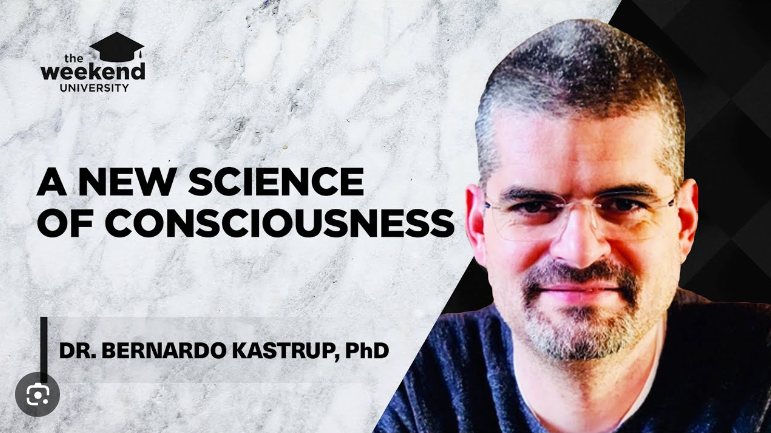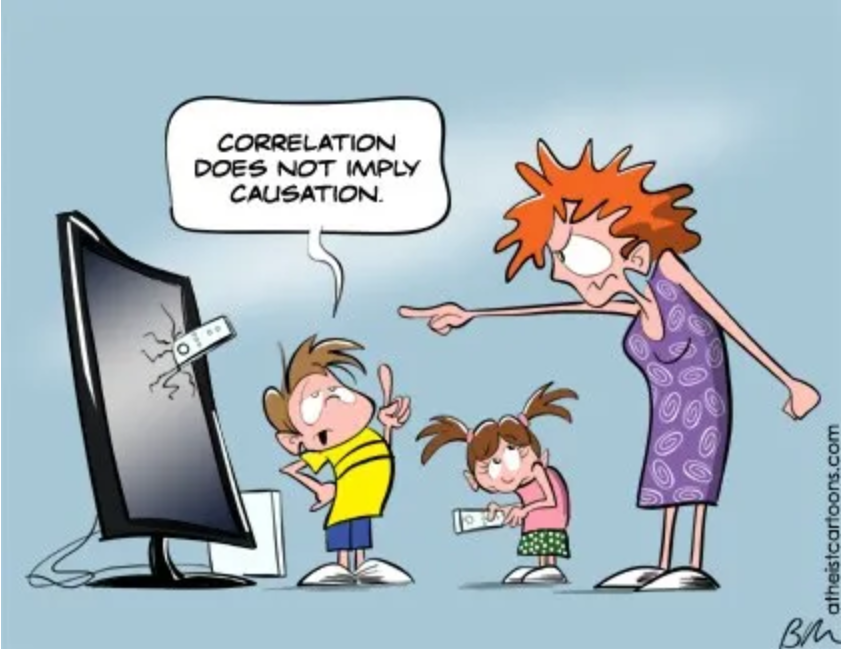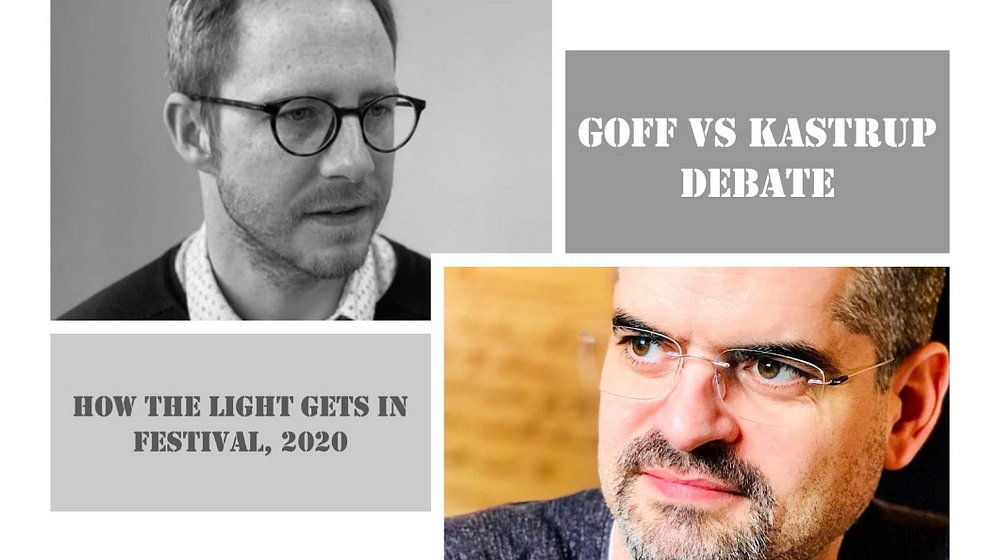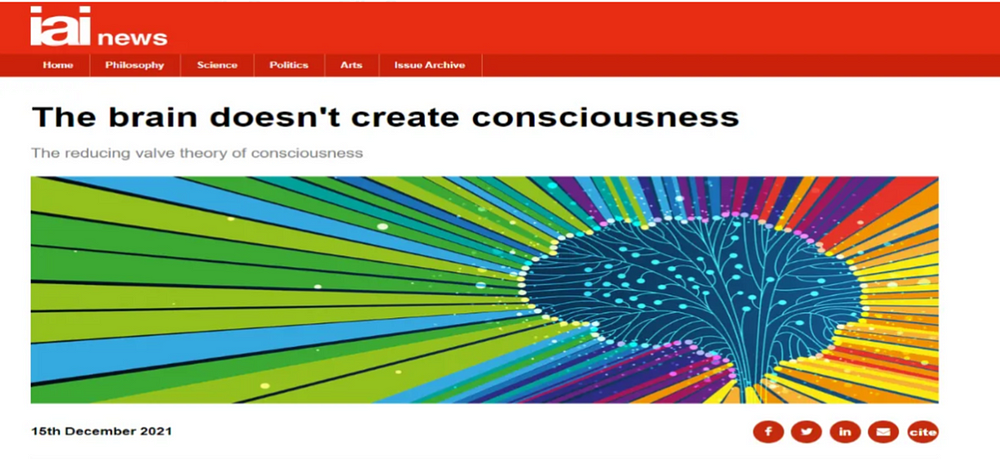
[All of Bernardo Kastrup’s words in the following essay come from a YouTube video called ‘‘Your Consciousness is Not in Your Head.’ | Interview with BERNARDO KASTRUP, PhD’. The interviewer is Péter Sárosi. The interview itself was recorded at the Interdisciplinary Conference on Psychedelic Research (ICPR) 2022, in Haarlem, the Netherlands.]
Part One
Part Two
Introduction: Bernardo Kastrup and Science

Bernardo Kastrup is keen to tell us that he’s not actually against neuroscience. It’s just that he believes that neuroscience isn’t enough.
Take the following passage:
“I think there is nothing wrong with interpreting brain imaging from a scientific perspective. That’s the primary way to study the mind because our only access to someone else’s mind is brain imaging, fMRI [] EEG [and] PET [scans] and so on. So I have nothing against that.”
To Kastrup, the “scientific perspective” is fine. However, he doesn’t believe that it’s enough. Kastrup believes that we also need a philosophical perspective. That is, we need an idealist perspective. Indeed, we need Kastrup’s very own idealism.
Kastrup believes that he’s offering a philosophical take on the neuroscience. In technical terms, the brain is the (to use Kastrup’s own words) “image” or “representation” of the mind.
The Mind Generates the Brain

As already stated, Kastrup wouldn’t deny that he’s doing philosophy (i.e., not science) here. However, he holds the position that (what he calls) “materialist scientists” don’t realise that they’re doing philosophy when they claim that (to use Kastrup’s own words) “the brain [] generates the mind”.
It’s true that a fair few scientists (including writers of popular science) don’t seem to realise the philosophical aspects of the theories they endorse and the statements they make. However, believing that the brain generates the mind doesn’t seem to be a philosophical at all.
That said, if scientists believing that the brain generates the mind is a philosophical position, then it is so only in the sense that virtually all claims can be deemed to be philosophical in some sense or other. So the problem here is the following (as it’s often put):
If everything is x, then nothing is x.
You may as well say that when someone claims that legs generate walking (or that a punch in the nose generates bleeding), then that is (as Kastrup puts it) “doing philosophy”.
Kastrup then restates the famous correlation-doesn’t-imply-causation idea (if in his own way).
Correlation Doesn't Imply Causation

In the interview on YouTube, Kastrup tells us the following:
“There is a correlation between the two [i.e., between brain and mind]. We can learn a lot about one from the other. In other words, we can learn a lot about the mind from brain imaging. But when we interpret that correlation as implying a certain causation (like the brain causes the mind), that’s when we will artificially narrow our horizons. And I think that is unjustified. That’s a philosophical step, and it’s a bad one. There are plenty of reasons to think that the brain does not generate the mind.”
[See Wikipedia’s ‘Correlation does not imply causation’.]
This is Kastrup reiterating his view that the brain doesn’t cause the mind. However, Kastrup makes it seem as if scientists simply note certain correlations, and then quickly and wildly jump to believing that the brain causes the mind…
For a start, there may be some kind of correlation between a cock crowing in Somerset and John Smith eating his lunch in Dorset. However, no scientist I know would believe that the cock crowing caused John to eat his lunch. [This example is based on David Hume’s own examples in which he too tackles causation and correlation.]
The same is true of the brain and mind.
It’s not only that there are correlations. Full stop!
Those correlations are systematic, and lots and lots is known about them. Thus, there are a whole host of scientific, logical and philosophical reasons to believe that it’s not just a question of correlations. Indeed, it’s about a hell of a lot more.
Yet Kastrup himself doesn’t mention any of this extra scientific, logical and philosophical detail. Again, he makes it seem as if all neuroscientists fall for the silly correlation-must-imply-causation mistake — literally without any thought.
So discussing the philosopher Philip Goff’s position on identity will be helpful here.
Philip Goff on the Non-Identity of Pain Y With Brain State X

According to Philip Goff’s take on the position of identity theorists, there’s a far-too-quick move from the fact that pain Y is “systematically correlated with brain state X”, to the conclusion that
“we can [therefore] simply assert the identity and the case is closed”.
So is Kastrup himself basically making the same kind of point as Goff?
In this case, however, Goff isn’t discussing whether “the brain generates the mind” (or vice versa): he’s discussing whether a (particular) brain state can ever be identical to a (particular) mental state. In addition, Goff’s position is far less extreme (or simply less radical) than Kastrup’s. That is, he’s not questioning that the brain somehow (to use Kastrup’s word) “generates” pain Y. He’s asking his readers whether or not pain Y can be (or actually is) identical to brain state X.
Again, it’s not literally all about correlations.
It’s not only that brain state X and pain state Y are correlated which automatically leads to positing an identity (or, in Kastrup’s case, positing a causal relation) between them. It’s that these systematic correlations give the philosopher or neuroscientist very strong reasons to believe that there is — in fact — an identity (or a causal relation).
The following passage is how the American experimental psychologist Edwin Boring (as quoted by U.T. Place) put it in the 1930s:
“To the author a perfect correlation is identity. Two events that always occur together at the same time in the same place, without any temporal or spatial differentiation at all, are not two events but the same event. The mind-body correlations as formulated at present, do not admit of spatial correlation, so they reduce to matters of simple correlation in time. The need for identification is no less urgent in this case.”
In addition, the following passage is how the philosopher Valerie Gray Hardcastle went on to put it some 60 years after Boring:
“[I]f you find structural isomorphisms between our perceptions and twitches in the brain, then that is taken to be a good reason to think that the mind is nothing more than activity in the brain. (What other sort of evidence could you use?)”
It’s of course the case that readers don’t need to agree with everything in those two just-quoted passages. (I don’t.) They’re quoted simply because they clearly show that this issue has never been exclusively about “mere correlations”.
Indeed, that seems downright obvious.
Those who claim (whether explicitly or implicitly) that “materialists” or neuroscientists believe that it’s all about correlations seem to be either displaying bad faith, or simply showing their ignorance of neuroscience and philosophy.
Sure, it’s certainly the case that not all correlations entail — or even imply — causation (or, in Goff’s case, identity). It’s just that in some cases they do!
So the following comparison will distinguish Goff’s position from Kastrup’s.
Smoking lots of cigarettes came to be strongly correlated with lung cancer. However, smoking lots of cigarettes is still not (to state the obvious) identical to lung cancer. Instead, smoking lots of cigarettes has often caused lung cancer.
Kastrup’s Reasons to Believe the Mind Generates the Brain

In the passage above, Kastrup told us that
“there are plenty of reasons to think that the brain does not generate the mind”.
Kastrup may well have plenty of reasons to believe what he believes.
However, there are also plenty of reasons to believe that the earth is flat, or that God is benevolent/malevolent, or that alien lizards rule the world.
Are they good reasons?
In Kastrup’s case, all his reasons to believe that the brain doesn’t cause the mind come from his commitment to idealism, as well as to his commitment to various religious (or “spiritual”) ideas and texts (+ the work of Carl Jung).
In any case, why should “the mind look like a brain” in the first place?
Surely everyone outside Kastrup’s own idealist (as it were) school would have problems with that statement.
That said, Kastrup does seem to go into some detail. For example, he says:
“The brain is the image of the mind. It’s the cognitive representation we make of another mind, not the generator of the mind.”
However, exactly the same question as earlier can now be asked:
Why should “the mind look like a brain” in the first place?
In Kastrup’s own jargon, why should the brain be the “cognitive representation of another mind” at all? Why can’t a lemon (or a triangle) be be the cognitive representation of another mind?
Kastrup then returns to the earlier theme of the mind causing the brain (not vice versa) by adding the following words:
“We are mental creatures, and our mentation when observed from the outside looks like a physical body and brain.”
Again, why does “our mentation [] look[] like a physical body and brain”?
What’s more, why are we “mental creatures”?
Does Kastrup mean that “we [are] essentially” (or exclusively) mental creatures?
Of course, all this also ties into Kastrup’s underlying idealism.
In other words, literally everything in the universe is “mentation” in Kastrup’s idealist worldview.
Yet again, why should mentation (or mind) look like “a physical body, a brain and body” in the first place? Why doesn’t mind look like a lemon (or a triangle)? More tellingly, the fantastic complexity of the brain is ignored when it comes to Kastrup’s categorical statements. Indeed, according to his idealist vision, that fantastic complexity of brains is simply a stand-in for our mentation — or for the (to use Donald Hoffman’s term) “projections” of our minds…
Donald Hoffman?
It’s worth noting here that Kastrup’s general position on brains and minds is almost identical to that of the cognitive psychologist Donald Hoffman.
Part Two
Bernardo Kastrup and Donald Hoffman

Bernardo Kastrup’s idealism is very similar to Donald Hoffman’s idealism too…
That’s except for the fact that Hoffman uses the words “icon” and “interface”, whereas Kastrup uses the words “image” and “representation”. However, these differences in terminology don’t actually make a big (or even a small) difference.
(Hoffman calls his own brand of idealism “conscious realism”. Kastrup uses the term “analytic idealism” about his own brand.)
In detail.
Hoffman has stated that “brains and neurons do not exist unperceived”. That isn’t a claim that our perceptions don’t (as Hoffman puts it elsewhere) “resemble” whatever it is that (to use Kastrup’s word again) “generates” them. Instead, this is an explicit claim that brains and neurons don’t exist when unperceived.
Hoffman makes his Berkeleyan position even clearer in the following passage:
“The phenomenal volleyball [or brain] isn’t there when you don’t look [].”
Hoffman also wrote this simple line about a brain:
“If you don’t look, it’s not there.”
Then Hoffman immediately adds the following scientific gloss on his idealist position:
“The relational volleyball is circuits and software, and it isn’t literally off-white either. There may be portions of the software whose intent is to spray photons on your eyes such that you will construct an off-white phenomenal volleyball. But this software isn’t any color at all. And the color of the circuits is irrelevant to the color of the phenomenal volleyball[].”
Yet if you don’t look at what’s defined as (to use Hoffman’s word) “phenomenal”, then of course it’s not there as a phenomenal object when no one is looking at it.
That’s true by definition!
However, most people won’t also accept that that the physical brain is only there when someone is looking at it. Of course, Hoffman collapses this distinction between a phenomenal brain (see ‘Phenomenalism’) and a physical brain.
Again, a physicalist can accept Hoffman’s term “phenomenal volleyball” (or phenomenal brain). A “phenomenon” is by definition something that only belong to minds or to conscious experiences. [Phenomenal = “known through the senses”.] Historically, that’s essentially how that word was used by Immanuel Kant some 240 years ago. In Kant’s scheme at least, we have phenomena, and we also have noumena. (Readers — and others —needn’t accept these Kantian terms and philosophical distinctions at all.)
All this means that if a brain is entirely defined as a phenomenal brain, then by definition it can’t exist if no one is looking at it. However, that’s because — again — Hoffman simply means phenomenal brain by the single word “brain”.
So, more relevantly, is Kastrup himself making the same mistake as Hoffman?
Finally, just as I’ve compared Kastrup to Hoffman, so both Kastrup and Hoffman can also be compared to the New Age writer and businessman Deepak Chopra.
Bernardo Kastrup and Deepak Chopra

In a Medium essay called ‘Is Your Brain an Illusion?’, Chopra wrote:
“Take away the light, brightness, and images, and the experience of seeing is gone. It stands to reason that your brain doesn’t see, and once this point is conceded, it is the opening edge of the wedge. If the brain doesn’t see, then it doesn’t possess any of the five senses. If that’s true, then the brain has no experience — and yet you do.”
I don’t really understand this passage. Even in the context of Chopra’s entire essay, it’s hard to see what he’s getting at.
The second sentence (“once this point is conceded, it is the opening edge of the wedge”) seems like a non sequitur. And yet, according to Chopra, “it stands to reason [that the] brain doesn’t see”.
It’s not clear if Chopra includes the eyes as being part of the brain. [See here.] It’s certainly the case that if he doesn’t, then that may well explain at least some of his words…
Anyway, none of these technicalities really matter.
That’s because Chopra’s main point is idealist in nature. (In Chopra’s words: “The brain has no experience — and yet you do.”) In other words, the brain isn’t required for experiences. Or, in Kastrup’s terms, the brain is the “image” (or “representation”) of Chopra’s “you”. Alternatively, in Hoffman’s terms, the brain is an “icon” of Chopra’s you.
All this leads to talk of “cosmic [or universal] consciousness”, which is a very-popular subject when it comes to “spiritual” people and idealists. [See here.]
Universal Consciousness and the Field of Subjectivity

Kastrup claims that “the words ‘universal consciousness [are] perfectly descriptive”.
Why are these words perfectly descriptive?
According to Kastrup, they’re perfectly descriptive because “consciousness has no boundaries within the physical universe”.
Really?
Who says so?
Well, Kastrup certainly says so.
Basically, Kastrup (scare-quoted) “explanation” doesn’t explain anything. However, his supporters and fans may simply accept it because it sounds and feels good to them.
In any case, what is it, exactly, that “has no boundaries within the physical universe”?
Telling me that it is consciousness that has no boundaries is to tell me nothing.
What’s more, Kastrup then simply substitutes the word “consciousness” with the words “field of subjectivity” — as in the following:
“A more technical way to to describe it would be a field of subjectivity that has no spatial bounds.”
So now we can ask these two questions:
(1) What is this “field of subjectivity”? (2) Why is it universal?
Does this field of subjectivity stretch to the HD1 galaxy, which is some 13.5 billion light-years away?
And even if it does, then what is this field of subjectivity which stretches to the HD1 galaxy?
More narrowly, how is the word “subjectivity” being used by Kastrup? [Subjectivity = “the quality of existing in someone’s mind rather than the external world”.]
Doesn’t subjectivity require a subject who (or that) is more than its/his/her/etc. subjectivity? (Otherwise we’re in danger of going around in circles.)
Who or what is the subject here?
Does consciousness — i.e., not subjectivity — being deemed to be “fundamental” help us here?
In any case, we now get another categorical passage from Kastrup: this time about about the (or his) “field of subjectivity”. It goes as follows:
“The unbound field of subjectivity that underlies our nature. And because we are part of nature, that field of subjectivity underlies us. And that’s why we are essentially subjective creatures.”
As before, the words “the unbound field of subjectivity that underlies our nature” just amount to a categorical statement. Indeed, the passage above basically reads like a quote from some kind of religious text.

Kastrup, Hoffman and Chopra on Religion

Some readers have responded to my previous essays by saying that I unfairly bring up religion when discussing the work of idealists, dual aspect monists, etc. [See Medium writer Gerald R. Baron’s ‘Paul Austin Murphy on Motivations for Anti-Physicalism’. [Edit: note that a responder to this essay has made exactly the same point! See responses.)]
However, these idealists do so too!
Indeed, in the same essay just quoted (‘Is Your Brain an Illusion?’), so does Deepak Chopra himself. For example, Chopra writes:
“Maya exposes the fallacy that the brain is the same as the mind. Neuroscience would adamantly deny this, because the entire basis of brain science for 99% of neuroscientists, is that brain = mind.”
[See note on ‘Maya’.]
Chopra becomes even more explicit (or open) in the following passage. (He uses the words of Erwin Schrödinger to give his spiritual idealism some scientific credence.) Here goes:
“The reason it matters was summarized by another great quantum pioneer, Erwin Schrödinger, who was a great student of Vedic philosophy and particularly of its main documents, known as the Upanishads. ‘The Upanishads are the most comprehensive philosophical treatise ever written by man. They are based on an ancient idea, as old as Indian thought itself, that the most profound reality is One and that this One is identical with our own Self.’”
[Erwin Schrödinger was a great physicist, not a great philosopher or a great commentator on Vedic texts.]
Of course, neither Kastrup nor Hoffman are as explicit about their religious influences as Chopra is. That said, like Chopra himself, both Kastrup and Hoffman are idealists. Both are friends with Chopra. [See Hoffman and Chopra here, and Kastrup and Chopra here.] And both do indeed cite and mention (if less often than Chopra) various religious texts and ideas.
Note:
This is one definition:
“Maya, literally ‘illusion’ or ‘magic’, has multiple meanings in Indian philosophies depending on the context. In later Vedic texts, māyā connotes a ‘magic show, an illusion where things appear to be present but are not what they seem’; the principle which shows ‘attributeless Absolute’ as having ‘attributes’.”









No comments:
Post a Comment